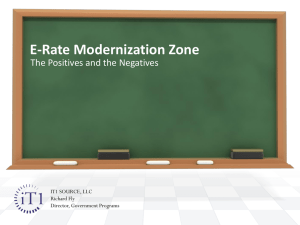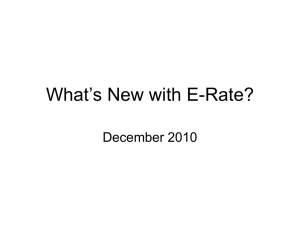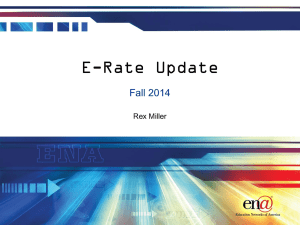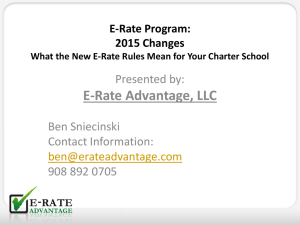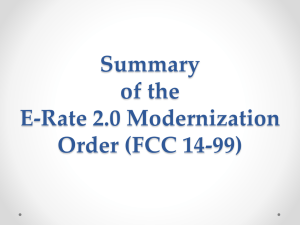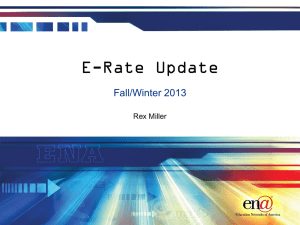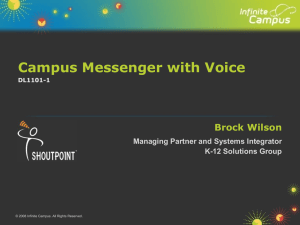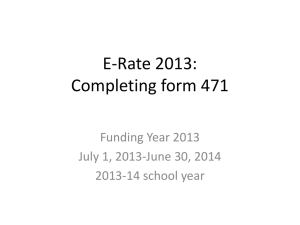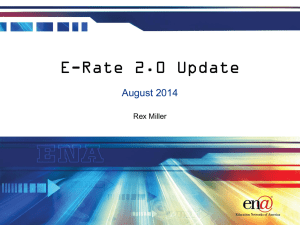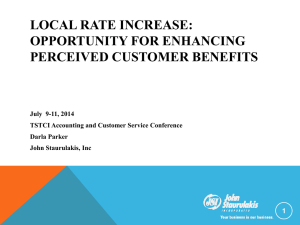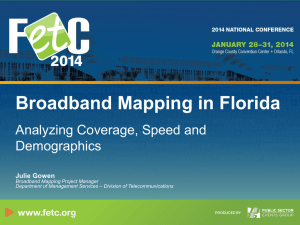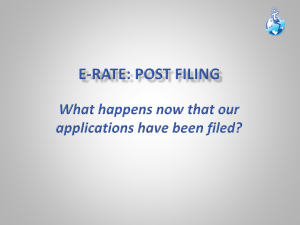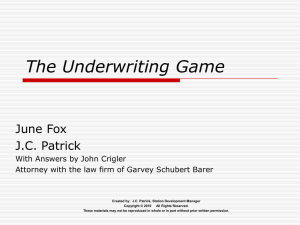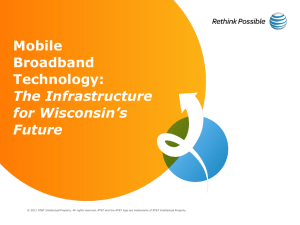E-rate 2.0 NPRM: Preview of Possible Changes
advertisement
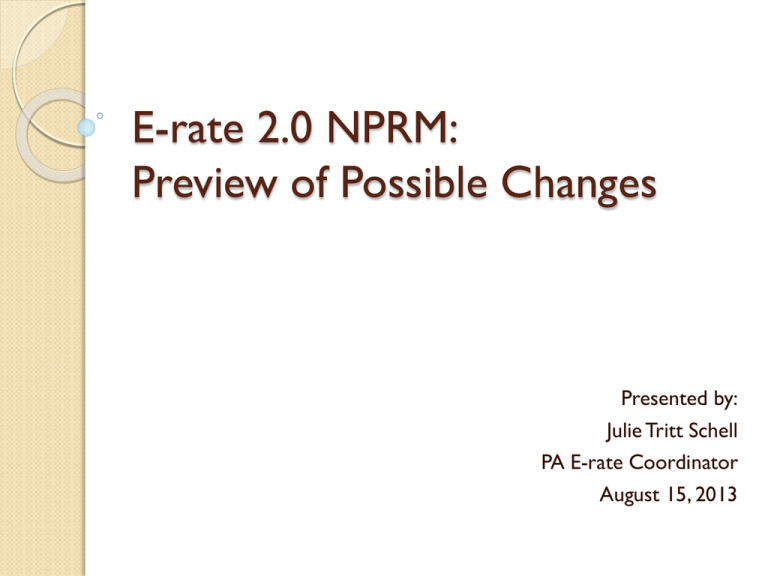
E-rate 2.0 NPRM: Preview of Possible Changes Presented by: Julie Tritt Schell PA E-rate Coordinator August 15, 2013 Agenda History of E-rate Reform Summary of 17 Major Topics in NPRM How To Submit Comments to the FCC 2 History of E-rate Reform March 2010: National Broadband Plan Released December 2010: FCC Adopt Erate Reforms June 2013: President Obama Announces ConnectED July 2013: FCC releases Erate 2.0 NPRM 3 National Broadband Plan March 2010, the National Broadband Plan (NBBP) was released by the FCC. http://www.broadband.gov/plan The 376-page plan set broad national broadband goals for government, consumers, homeland security, health care, energy, and education. The education section was 21 pages, with 6 pages devoted to E-rate. There were 12 E-rate recommendations, most of which are contained in the E-rate 2.0 NPRM. 4 Interim E-rate Reforms In September 2010, FCC adopted these E-rate reform measures: Allowed applicants to lease fiber from any provider (not just telecommunications carriers). Allowed applicants to lease unlit existing fiber. Allowed the community to use E-rate eligible services after hours – on school campus. Allowed E-rate funded services to be provided to most dorms. Create a 1-yr pilot competitive pilot program that provided funding for off-campus wireless connectivity through mobile devices. Increased the E-rate funding cap to annual inflation (it is currently capped at $2.25 billion). Eliminated the E-rate tech plan requirement for Priority 1 services. 5 ConnectED In June 2013, President Obama introduced the ConnectED initiative: Within 5 years, connect 99% of schools to 100 mbps, with a target of 1 Gbps. Provide high-speed wireless connectivity within their schools and libraries. Called on the FCC to make this happen. FCC can change E-rate without Congressional approval. We know they are working closely on reform and funding efforts. 6 E-rate 2.0 NPRM In July 2013, FCC released E-rate 2.0 Notice of Proposed Rulemaking (NPRM). Not what was expected. Massive document containing 175 pages (97 pages of relevant text). 616 questions and 357 ideas on which comments were requested. NPRM divided into 6 categories I. Introduction II. Goals and Measures III. Ensuring schools and libraries have affordable access to 21st century broadband that supports digital learning IV. Maximizing the cost-effectiveness of E-rate funds V. Streamlining the administration of the program VI. Other outstanding issues 7 E-rate 2.0 NPRM General This presentation tries to outline 17 major issues/topics being considered. None of the proposals/topics is final. FCC is seeking feedback from the applicant/vendor community whether they are on the right track and why/why not. Some of the topics are actual proposals; others are issues for which they are seeking comments. I strongly encourage you to weigh in on any and all of the issues you feel strongly about. The FCC reads all comments submitted and are especially fond of real-world school and library submissions. 8 NPRM Resources Page http://e-ratepa.org/erate_2oh.htm 9 Make Broadband Priority 1 FCC survey data indicates that 80% of the applicants surveyed stated they did not have sufficient bandwidth. FCC proposes to update E-rate priorities so that highcapacity broadband and the associated equipment needed to disseminate that broadband to and within those buildings becomes Priority 1. All other services would become Priority 2 or phased out altogether (¶ 65) What different or additional services should be considered eligible such as filtering, caching and network security services, etc? 10 Treat Lit and Dark Fiber Equally The FCC proposes to treat lit and dark fiber more consistently by making modulating electronics and special construction charges eligible as part of dark fiber (as it now does for lit fiber). (¶ 71) Asks many questions related to fiber deployment: What are barriers to fiber deployment? Should E-rate support the purchase of WANs if it’s more cost effective than leasing? (¶ 80) Should the one-time installation costs receive a higher discount? Can the FCC do anything to reduce recurring costs over time by altering any of its policies Should the Eligible Services List be amended to include additional equipment that is needed for broadband connectivity within buildings? 11 Revise Eligible Services List The FCC proposes to phase out support for a number of specific services including: ◦ paging ◦ wireless text messaging ◦ directory assistance ◦ custom calling features ◦ inside wiring maintenance plans ◦ call blocking ◦ 800 number services. (¶ 90) When should such changes be made? FY 2014? 12 Revise Eligible Services List The FCC also seeks comment on whether support for the following services should be phased out, de-prioritized or eliminated: ◦ All voice services (presumably basic telephone service, local and long distance ◦ If so, should VOIP continue to be eligible? (¶ 105) ◦ Internet access provided via cellular data plans, including aircards. (¶ 102) ◦ Web hosting and hosted e-mail services. (¶ 97) ◦ Basic maintenance of internal connections. (¶ 101) Should other items on the Eligible Services List that are not directly related to high-capacity broadband be ineligible? (¶103) 13 CIPA The FCC seeks comment on several CIPA related questions, including: Are laptops, netbooks with Internet access, smartphones, and Internet enabled e-readers considered computers that must comply with CIPA? Are personally owned devices that are not owned by schools and libraries required to be CIPA compliant when used oncampus? Are school-owned devices used off campus and used with outside networks required to be CIPA compliant? (¶271) 14 Establish Connectivity Goals The State Education Technology Directors Association (SETDA) has set the following goals: INTERNET connectivity goal of 100 Mb per 1000 users by 2014 (increasing to 1 Gb per 1000 users by 2017). WAN connectivity goal of 10 Gb per 1000 users by 2017. Should the FCC adopt these goals? Are these targets appropriate for all schools? How are schools’ bandwidth needs changing, particularly in those schools that have one-to-one initiatives? What should the goals be for schools that have very few students? How should the FCC measure and monitor progress to such goals? (¶ 22) Should applicants have to install monitoring equipment to identify how much bandwidth they are actually using? 15 Streamline E-rate The FCC proposes several options for streamlining the administration of the E-rate program, including: Requiring all forms and USAC correspondence to be submitted/sent electronically (¶ 227); Providing more detailed and comprehensive funding statuses throughout the application process (¶ 232); Speeding review of applications and issuance of commitment decisions (they seek specific comments on problems they have had during the PIA review process) (¶ 233); Removing the distinction between telecommunications services and Internet access (¶ 258); Considering lesser recovery actions for rule violations (¶ 252); More effectively identifying and capturing unused funds (why do funds go unused and how can USAC identify and de-obligate those funds more quickly?) (¶ 254); and Streamlining the E-rate appeals review process (¶ 266). 16 Change Funding Distribution Model The FCC seeks comment on 4 major options for revising the structure for distributing E-rate funds as follows: 1) Revising the discount matrix to increase certain applicants’ matching requirements through a phase-in process. (¶117) What should the maximum E-rate discount be? 70%? 75%? Should all of the discount bands be adjusted downward by a certain percentage? Should the discount matrix be abandoned in lieu of a discount calculated as NSLP percentage plus 20% (urban) or 25% (rural)? 2) Incorporating a per-student or per-building cap on funding into the discount matrix. (¶ 135) What would those caps be? Should they apply to both Priority 1 and Priority 2 funding? Should installation fees be excluded from the calculation? Should there be a di minimus amount funding available? How would consortia apply using a per-student cap? 17 Change Funding Distribution, continued 3) Providing more equitable access to Priority 2 funding (¶ 133) How can the FCC ensure more applicants have access to P2 funding Should the 2/5 rule be replaced with another rule, such as a 1/5 rule? Should P2 be funded on a rolling-funding cycle? Should there be different priorities established, such as a broadband/Internet P1 category and other service (such as voice) become Priority 2 (or some other priority)? 4) Allocating funds through a fixed dollar amount before the funding year begins (¶ 149) How would this amount be calculated for libraries? How would it be calculated for schools? How would this work with consortia? What would the reporting requirements be? 18 Change Discount Calculations The FCC proposes 2 major revisions to E-rate discount calculations: Changing the E-rate discount calculations to be based on a simple average of the District’s NSLP enrollment whereby a district would receive a straight matrix discount. The current formula is a weighted average approach that uses each school building’s discount as part of the calculation) (¶ 126) Districts would apply for all services (P2/P2) using district-wide discount; no building discounts would apply.) Changing the definition of rural to ensure greater funding to truly rural areas by using NCES codes. Should the definition be based on ‘rural’ or ‘remote-rural’ areas? (¶ 130) Should the rural schools and libraries receive a greater discount than they currently receive and should the rural factor also be incorporated into the highest discount bands? (¶ 133); 19 Increase Funding Cap The FCC seeks comment on whether to increase the $2.25 billion E-rate cap (temporarily or permanently) to ensure high-capacity broadband connectivity to and within schools and libraries. (¶ 173) 20 Reform Competitive Bidding The FCC seeks comments on how to reform the competitive bidding process. What are reasons that applicants do not receive multiple bids? How can they reduce the number of applicants that don’t receive multiple bids? Does the Lowest Corresponding Price Rule help ensure that applicants receive cost-effective prices? Should applicants be exempted from the Form 470 bidding process if they have complied with state procurement rules or if their total E-rate funding is below a certain amount? (¶ 202) Should applicants be required to submit all competitive bidding documentation with their Form 471s or should they be required to submit a bid evaluation sheet? (¶ 298) 21 Reform Competitive Bidding, continued Does the current system provide enough information to vendors to formulate bids? Should all state master contracts automatically be deemed E-rate eligible even if they were not procured under the E-rate competitive bidding system? Should the deadline for signing contracts with vendors be revised to make it easier to comply with E-rate deadlines? Should technical assistance be offered by USAC to help applicants figure out cost effective pricing options and/or planning and procuring cost effective networks? (¶191) 22 Increase Consortia/Bulk Buying The FCC seeks comment on ways to increase consortium purchasing (¶186) Does consortia purchasing reduce costs? How should the FCC encourage more consortia and other types of bulk buying opportunities? Should applicants be required to buy from state or regional master contracts Should the FCC or USAC establish a bulk buying program? 23 Increase Transparency The FCC proposes to increase the transparency and seeks comments on the following: Transparency of E-rate spending. ◦ How can the FCC increase transparency with respect to how Erate funds are allocated and spent? Transparency of prices available for E-rate supported services. ◦ How can the FCC best increase the transparency of prices for E-rate supported services? Transparency of prices being bid for E-rate supported services. ◦ Should the FCC consider making bid responses public or at least accessible to other E-rate applicants? Transparency of actual purchase prices. ◦ As an alternative to requiring public disclosure of all bids to provide E-rate services, should the FCC make available the prices applicants are paying for E-rate supported services? 24 Direct Payments to Applicants The FCC proposes to permit schools and libraries to receive BEAR reimbursement checks directly from USAC and not have to pass through the respective service providers (¶ 259). Should invoicing deadlines be more rigid in order to recapture and reuse unspent funds? 25 Permit Multi-year 471s The FCC proposes to have PIA only review the first year of a 3-year contract allow applicants, provided there was no changes to the contract or recipients of service in the second and third years of the contract. * In the second and third years, applicants would still have to request E-rate funding via the Form 471, but their contracts would not be subject to PIA review. Should the FCC also consider multi-year funding commitments? Should applicants only be permitted to sign contracts up to 3years in length? (¶ 241) 26 Expand Document Retention The FCC proposes to extend the E-rate program document retention requirements from five to at least ten years and seeks comments on the benefits and burdens of doing so. Should applicants and vendors be required to keep records of all communications relating to bids for and purchases of E-rate services/equipment? Should the additional retention period only be required on an “as-notified” basis? (¶ 295) 27 Permit Community Wireless Hotspots Should E-rate support be available for off-site Internet access for students and the general public through “community wireless hot spots?” (¶ 319) 28 Restrict Authorized Signatories The FCC proposes to require E-rate applications be required to be signed by a person with authority equivalent to that of a corporate officer (presumably this is to eliminate E-rate consultants from signing forms). (¶ 306) The FCC proposes to require a corporate officer of the service provider sign certain forms submitted to USAC. (¶ 300) 29 Filing Comments w/the FCC Deadline to submit comments is September 16, with reply comments due October 16. Comments should: Include your organization’s name and date on each page. Use a table of contents, regardless of the length of the submission. Track the organization set forth in the NPRM in order to facilitate or internal review process (i.e., refer to paragraph numbers from the NPRM). Begin with a short and concise summary of your argument. Be submitted in .PDF format. 30 Filing Comments w/the FCC To submit your comments, go to: http://apps.fcc.gov/ecfs/upload/display?z=xj9g5 Click ‘Submit a Filing’ at the top left under ECFS Main Links. That will take you to an input page, asking for contact information. ◦ Proceeding # is 13-184 Helpful filing guide available at: http://e-ratepa.org/erate_2oh.htm 31 Questions? 32
